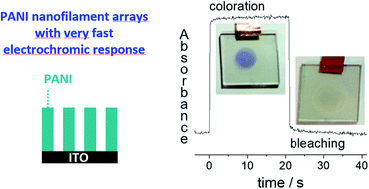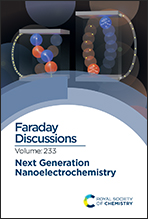Polyaniline nanowire arrays generated through oriented mesoporous silica films: effect of pore size and spectroelectrochemical response
Abstract
Indium–tin oxide electrodes modified with vertically aligned silica nanochannel membranes have been produced by electrochemically assisted self-assembly of cationic surfactants (cetyl- or octadecyl-trimethylammonium bromide) and concomitant polycondensation of the silica precursors (tetraethoxysilane). They exhibited pore diameters in the 2–3 nm range depending on the surfactant used. After surfactant removal, the bottom of mesopores was derivatized with aminophenyl groups via electrografting (i.e., electrochemical reduction of in situ generated aminophenyl monodiazonium salt). These species covalently bonded to the ITO substrate were then exploited to grow polyaniline nanofilaments by electropolymerization of aniline through the nanochannels. Under potentiostatic conditions, the length of polyaniline wires is controllable by tuning the electropolymerization time. From cyclic voltammetry characterization performed either before or after dissolution of the silica template, it appeared that both the polyaniline/silica composite and the free polyaniline nanowire arrays were electroactive, yet with much larger peak currents in the latter case as a result of larger effective surface area offered to the electrolyte solution. At identical electropolymerization time, the amount of deposited polyaniline was larger when using the silica membrane with larger pore diameter. All polyaniline deposits exhibited electrochromic properties. However, the spectroelectrochemical data indicated more complete interconversion between the coloured oxidized form and colourless reduced polyaniline for the arrays of nanofilaments in comparison to bulky films. In addition, the template-free nanowire arrays (i.e., after silica dissolution) were characterized by faster electrochromic behaviour than the polyaniline/silica hybrid, confirming the potential interest of such polyaniline nano-brushes for practical applications.

- This article is part of the themed collection: Next Generation Nanoelectrochemistry


 Please wait while we load your content...
Please wait while we load your content...